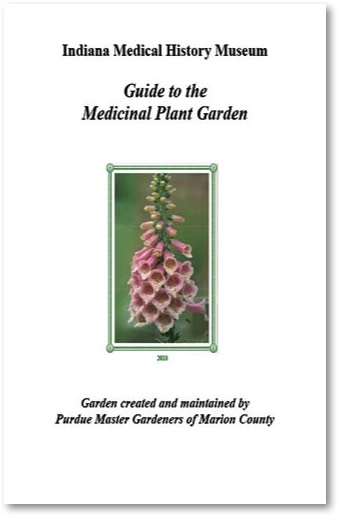
Musings » Guide to the Medicinal Plant Garden of the Indiana Medical History Museum


Indianapolis, Indiana
Indiana Medical History Museum 2010
Martha Woollomes, our immediate past president, grew up in Indianapolis and is an alumna of Purdue University in Indiana. She gave the library a copy of a wonderful document, a guide to the medicinal plant garden of the medical history museum in her native town. One of the first things that struck me about this booklet was the information that there are five more such gardens in the state of Indiana. Medical history, and its companion medicinal botany, are clearly alive and well in that state and being broadly disseminated by very active volunteers.
This garden is the achievement of the Purdue Master Gardeners of Marion County. They created it and they maintain it. (“Purdue” is a corruption of the old French phrase Pour Dieu.) The guide lists a hundred varieties of plant grown at one time or another for a medicinal effect.
Many of these plants are no longer used medicinally. Their efficacy was always uncertain. Some are extremely toxic, like foxglove (Digitalis purpurea). Others are so mild as to be without benefit. We enjoy this type as seasoning in our food, like thyme or sage. It was surprising to see sweet corn, (Zea mays), listed as a medicinal herb. Nowadays it is solely an article of diet, but at one time, the corn silk was considered to help urinary tract disorders. Aloe vera does still have a role in medicine.
The history of medicine is the history of botany. For centuries, physicians could not make any real difference to most diseases. Perhaps the only truly beneficial drug they possessed was opium, from the seed capsules of the poppy, (Papaver somniferum). This helplessness was not for want of trying. Medical students had to learn to recognize dozens of herbs and roots, and when they treated patients, they made probably nauseating concoctions which we would prefer not to think about. Various animal excreta and dejecta were included.
Marvellous books were written by the herbalists and physicians of the period. Almost everyone has heard of Gerard’s Herbal, published in 1597. Every bit of information was stuffed in uncritically, but these tomes were the forerunners.
In the early modern period, medical schools made teaching gardens (the “physic garden”) the centerpiece of their curricula. The first known one was in Bologna, started in 1584. The Chelsea Physic Garden in London remains an historic place. From “physic” (a Greek word meaning “nature”) and in its turn the root of the word physician, the gardens progressed to true botany.
What brought this about was the explosion of plants coming from newly discovered parts of the world. Quite suddenly the herbalists and naturalists were deluged with hundreds of new plants they had never seen, never suspected existed and for which they had no name and no system of classifying. To use the vernacular, modern biological science was “jump-started”.
Thank you Martha.

